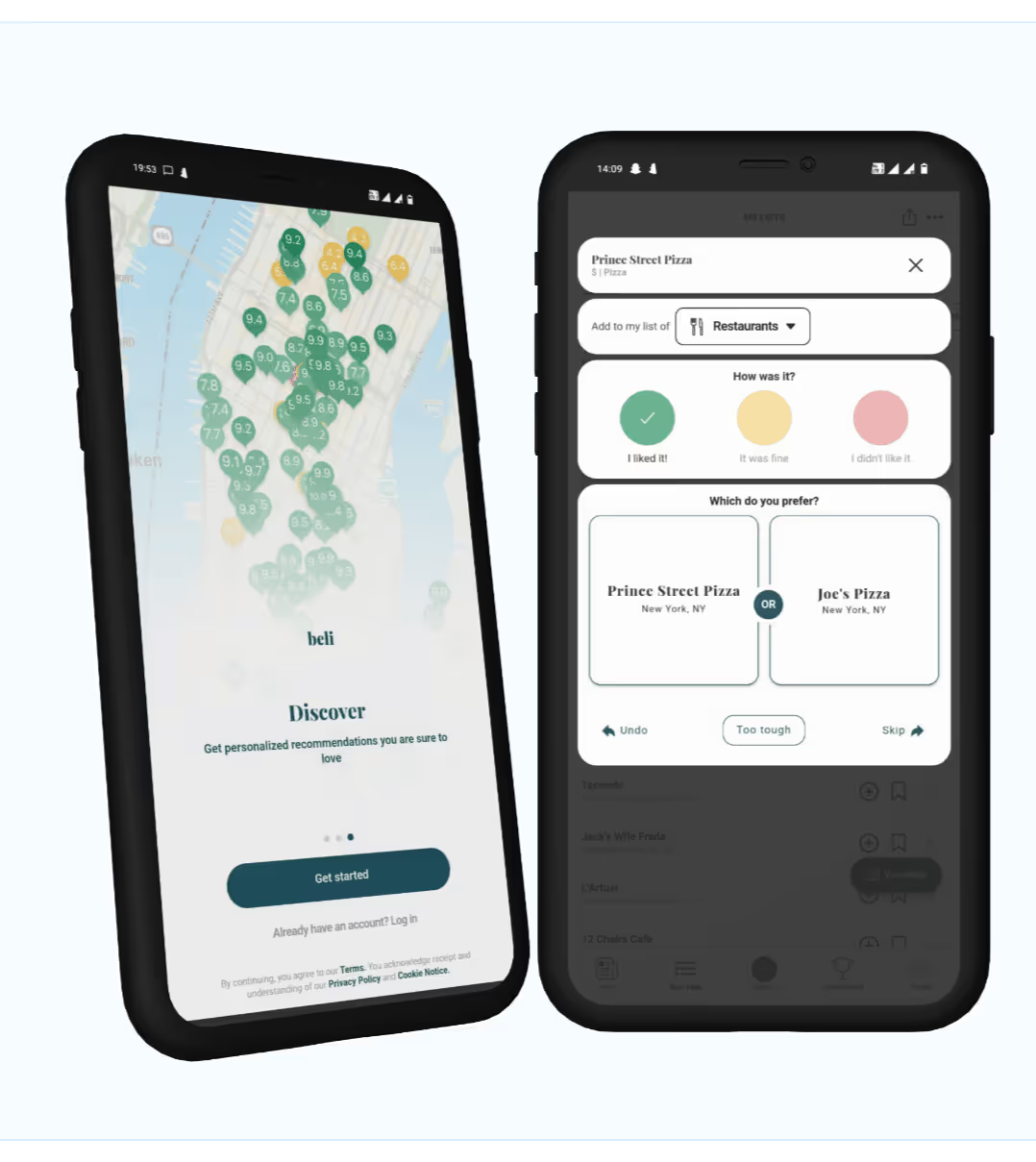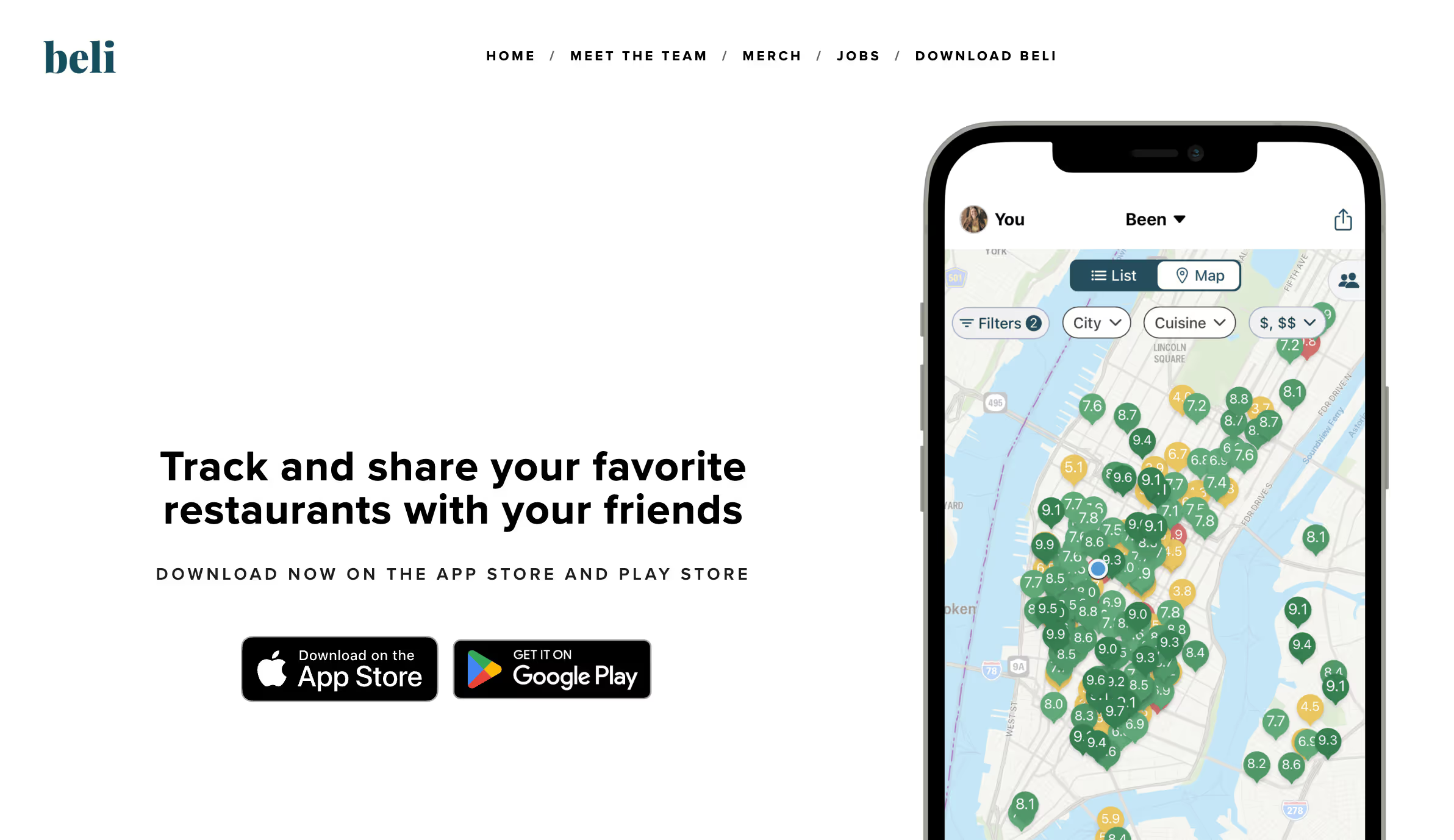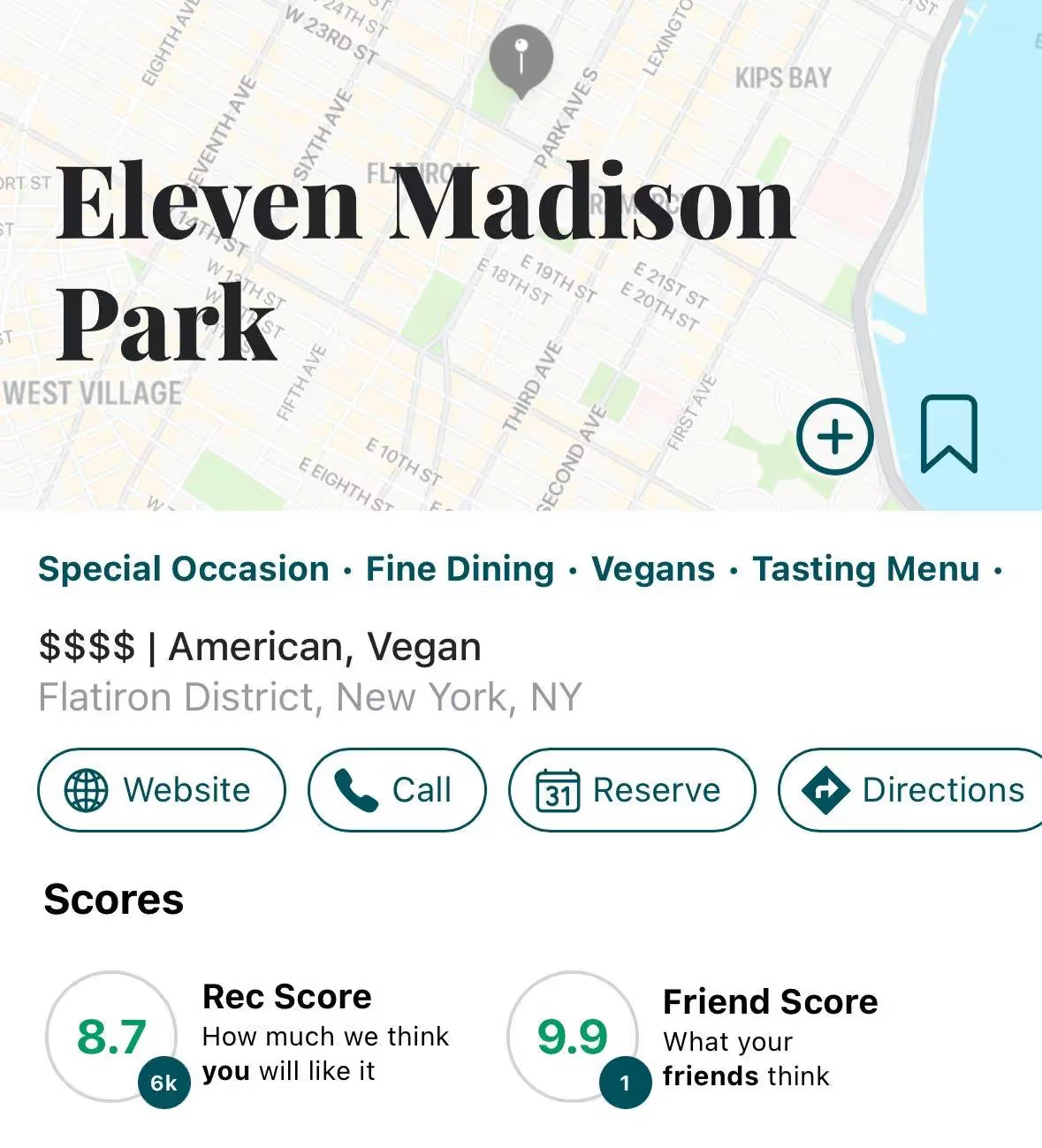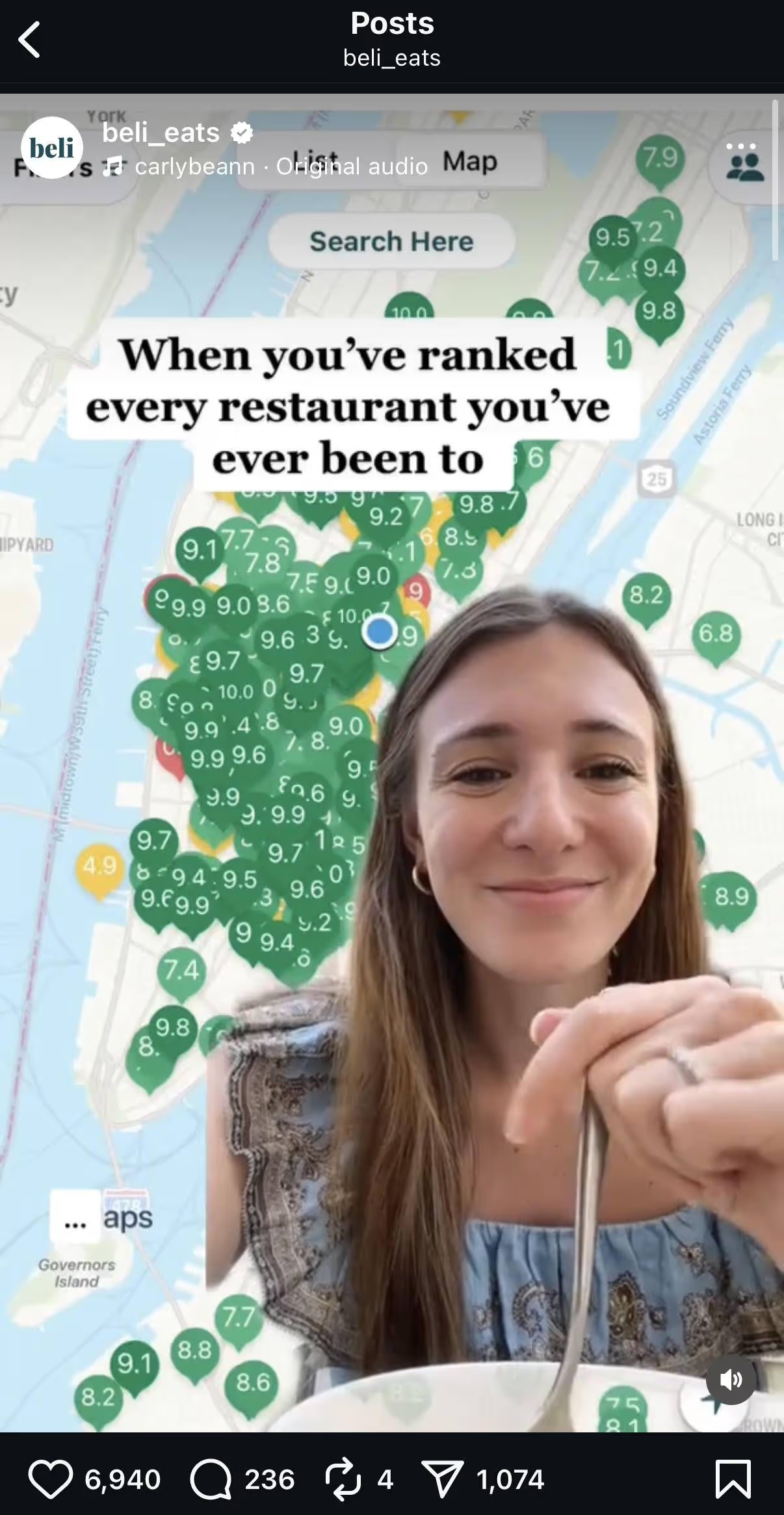Growth Newsletter #285
I’ve never thought of myself as someone who lived under a metaphorical rock, but the fact that I hadn’t heard of the Beli app until recently is making me question that.
Maybe it’s because I’m not part of the Gen Z audience this foodie app has a stranglehold on, or maybe it’s because my location in Raleigh isn’t a culinary mecca like NY, Chicago, or LA.
In any case, if you aren’t hip to this booming app, the TL;DR description is that it’s a more social, useful take on Yelp, specifically for restaurants.
Beli has caught fire like a tableside Bananas Foster preparation. And in a recent New York Times article, they cite the fact that Beli users have logged more than 75M reviews on the app since 2021, going toe-to-toe with Yelp’s review numbers over that timeframe (across ALL Yelp categories, not just restaurants.)
This growth story is a fascinating one, with many lessons to be learned for founders and those in the startup/tech spaces.
In this issue, we’ll examine how Beli used a few key growth bets (tight feedback loops, social mechanics, audience focus, and more) to hit product-market fit and disrupt a legacy category that wasn’t serving a younger audience.
Let’s dig into a sampler platter of reasons why Beli is blowing up.
— Gil
This week's tactics
How Beli Is Eating Yelp’s Lunch
Insight from Gil Templeton — Demand Curve Staff Writer
Before the two Beli founders, Judith M. Frost and Eliot P. Frost, married each other, their dates revolved around restaurants, like many do.
However, the couple took it to another level. They documented their dates on a Google Map and kept meticulous notes. They ranked restaurants, color-coded them, and added notes around their meal highlights and inside jokes.
“We weren’t just casually going to restaurants before. We were already pretty intensely tracking it, and that was how this idea came to be — always keeping lists and maps of restaurants.” — Judith M. Frost, Co-Founder & CEO, Beli
After enrolling at Harvard Business School together in 2018, the two began thinking of entrepreneurship more seriously, and they decided to build their startup over the summer between their first and second year.
Despite serious doubts and pushback from HBS peers and professors along the way, they persevered and doubled down on creating an app, which can pose a notoriously awkward path to revenue.
But the couple knew that there was an opportunity for more accuracy, depth, and especially a richer social element to dining experiences. And they knew they weren't the only intensely Type A foodies out there.
“So much of this is really about friendships and relationships. Dining is just this inherently social community thing. It’s all about getting people to go out and do things in the real world.” — Eliot P. Frost, Co-Founder & CTO, Beli
So the two combined the practical utility of a restaurant review platform with a curated, social-first approach to give Gen Z the foodie app they didn’t know they needed.
Fixing the Failing Five-Star Rating System
Before Beli, the platforms for vetting and discovering restaurants largely looked like Yelp, along with Google Reviews, Tripadvisor, and even reservation apps like Resy or OpenTable.
One major drawback of these platforms is the inflated, largely unhelpful five-star review format. In my personal experience, just about every worthy restaurant is somewhere between a 4.3 and 4.8.
The difference between being at the top or bottom of this tiny range could hinge on something that has little to do with the actual food or experience: a disaffected employee, a jealous competitor, a diner with a bone to pick, getting caught in the political crosshairs, people who just have different tastes than you, etc.
This chart below helps visualize this phenomenon, where many major review platforms see the majority of reviews clustered toward the top, creating a largely unhelpful group of neck-and-neck options.

Beli addresses this with a softer, more vibey approach that gradually shapes your profile inside the app and leads to curated suggestions. Instead of asking you to assign a rigid number 1–5, it gives you a green circle “I liked it!” a yellow circle “It was fine,” and a red circle “I didn’t like it,” which is much more in line with how I feel after leaving a restaurant than “That was a four-star experience."

It also asks for your preference between two restaurants you’ve visited, helping the app understand your personal hierarchy and taste, so it can tailor better recommendations for you. Again, this leans into how people actually think: "Yeah, it was great, but not as good as the other pasta place."
This might get difficult when comparing a pizza-by-the-slice joint to a Michelin-rated restaurant, of course, but it helps the app understand your unique preferences and continually hones the output, which leads to our next section.
Answering “What’s in It for Me?”
In addition to rethinking a questionable five-star rating system, Beli has flipped the script to make reviews actually serve the user, not just the restaurant or platform. This naturally fuels an engagement flywheel: the more quality input you feed it, the higher quality output you’ll receive, with a little sprinkle of social validation for good measure.
Instead of asking users to perform free labor for a thankless review platform, every personal rating and comparison helps train the app to know your palate better.
The more you use it, the more it feels like a spot-on personalized recommendation from a discerning concierge, not like you’re spending time shouting into the void or posting on some public message board.
So this becomes less about rating restaurants on an absolute scale, and more about defining your relative taste. And at the end of the day, isn't that what we're looking for? The best experience(s) possible for ourselves and our circle?
Here's how Beli fuels engagement and quality UGC.
The Beli Habit-Formation Loop
- Trigger: You get an invite from a friend (social cue) or hear about it on TikTok/Reels (environmental cue).
- Action: You log your first reviews: low-effort emoji-style responses (”I liked it") that give quick gratification.
- Variable Reward: You get personalized recs and friend-driven insights that feel novel and on-point each time you open the app.
- Investment: You add more restaurants, build out a profile, see your “taste graph” grow, recommendations continue sharpening.
- Reinvestment: Each new dining experience now feels unfinished until it’s logged, so you return to the app to review again. The app's algorithm keeps learning and offering better suggestions. And the cycle goes on.
“I just ranked my 200th restaurant on Beli. I try not to get too caught up in the game of it all — sometimes I catch myself drafting my review in my head towards the end of a meal. But I admit, the game can be really fun, and Beli keeps making it easier and easier to play.” — Sabrina Choudhary, Food Network Magazine
This loop provides serious value to users and plays a huge role in driving more engagement on the app. As we mentioned earlier, the app has seen more than 75M unique reviews since starting in 2021, with a cluster of super-reviewers leading the charge. Throughout a similar timespan, Yelp has fostered 83M+ reviews. However, this number is across ALL business types, not just restaurants.
The chart below shows how restaurants are just a slice of Yelp’s overall presence, meaning that in all likelihood, Beli is driving significantly more restaurant reviews than Yelp.

So instead of asking, “How can I spend my time to make the Yelp platform better today?” Users are instead thinking, “How can I provide feedback that leads to a better experience and maybe helps me look a little more hip to my peers?” And it’s working.
Beli is not trying to be the new Yelp, they are rethinking the utility of food reviews, and making it matter to the user in a tangible way, not just to climb the ladder of a clout-less Yelp leaderboard.
The Social Side of Foodie-Ism
But it's not just about sheer utility. Food is an inherently social activity that’s been bringing people together since…well, forever. But the “foodie” scene of the last twenty-ish years is more about social media than IRL experiences and memories.
Beli bridges this gap between food IRL and food on “social” screens in several powerful ways, and they lay it bare in their above-the-fold header that minces no words: “Track and share your favorite restaurants with your friends.” Those last three words are huge.

Another clear signal of Beli’s social-first approach (wrapped up in a bold growth tactic) is their heavily gated onboarding process. It forces prospects to invite four people into the fold before signing up, often through an auto-generated text message with a link.

This is a high-friction yet high-reward gambit that’s helping to fuel the app’s growth and “IYKYK” insider status. If three prospects stop here but just one takes the bait, the app “breaks even” in the short term, with more long-term potential and a free hit of brand awareness to boot. It also signals to users that this is a social, peer-to-peer experience by nature, right off the bat.
However, it's a tall order that gives some users (i.e. me) pause, and some people feel a little slimy sending the invites to their friends. For friends who don’t know Beli, it might look like a phishing message or like you got hacked.
I saw a LinkedIn post where a woman invited four friends to the app, and she received these texts in return:
- “Were you hacked?”
- “This looks like spam.”
- “Call me to confirm this is from you.”
- “Is this a supper club?”
It’s bold, for sure. But when you’re the hot new app with tons of momentum and “it” factor, you can get away with it.
Get it while you can, Beli. It’s hard to stay hip for long as a social media platform.

Another way Beli leans into the social aspect of the app is through two scores for each restaurant: a Rec Score and a Friend Score. The first of which is a composite from all users, and the second is specifically from your friends.

As mentioned earlier, people do not assign a numerical rating to their experience, the app generates these numbers relative to the green/yellow/red votes and the head-to-head restaurant comparisons.
This feature lets you see if people in your circle (presumably with similar taste) had a good experience or not. It also gives users a reason to text or call the friend who’s been there, opening up some natural, off-app dialogue around the experience.
To round out this section on how Beli trades in social capital, Beli is becoming a straight-up status symbol. On one hand, if you are logging the most expensive restaurants on a regular basis, that’s a signal you’ve got money. And on the other hand, if you’re hitting the hippest spots in town, that’s a signal you’ve got good taste and you’re in the know.
“People began sharing their rankings on dating apps to brag about their good taste or vet potential partners.” — Sabrina Choudhary, Food Network Magazine
Beli Speaks Gen Z
Beli says about 80% of their users are under the age of 35.
On the other hand, a meager 24% of Yelp users in the US are between 18 and 34.
The numbers don’t lie, and the contrast between the two couldn’t be more staggering.
Yelp simply hasn’t evolved its model to serve the wants and needs of a younger crowd, and Beli has fully seized this market opportunity.
“No one in my generation writes on Yelp.” — Sofia Jain, 28, prolific Beli restaurant reviewer
Gen Z consumes food and lots of content about food. They’re chronically online, yet they value connection and authenticity.
This app allows them to have both: a memorable and unique social experience, bookended by initial research/discovery and sharing their experience back out afterward.
“My highest rankings on Beli are the dinners I’ve had with friends where none of us touched our phones.” — Elya Rak, first-year student at NYU
In addition to appealing to Gen Z’s psychographics, it makes plenty of business sense to appeal to this generation as well, considering Gen Z visits more restaurants more frequently than any other generation in the US right now. While it probably wasn’t intentional, this happy accident is only pouring fuel on the foodie fire.
All-In On TikTok & Reels
Back before Beli even had an app on the App Store, they had a viral moment that generated thousands of signups on their website (still pinned at the top of their TikTok and IG feed). It was a Reel that featured co-founder Judith showing off her impressive personal Beli map over a funny viral audio clip: "Yeah, no, I would love to go with the flow, but like, what time does the flow start?"

Ever since that validating moment when they realized there were many more Type A foodies out there, they’ve been all-in on TikTok and Reels. And they’ve maintained plenty of discipline and focus on these two platforms to help them grow.
Their organic feeds on TikTok and Instagram consist entirely of pristine videos. Absolutely mouthwatering video hooks, professional VOs, highly visual reviews of amazing restaurants. They also lean into their review/ranking DNA by posting “best of” compilations with defined themes, like “Top 12 U.S. Burgers, Ranked.”

These high-quality organic posts typically grab hundreds of thousands of views and tons of shares, helping them reach new audiences through disciplined, focused efforts. If it ain't broke, don't fix it.
But the real value Beli delivers to social media is OFF TikTok and Instagram, because it lets people “peek under the hood,” so to speak.
Because if you’ve seen foodie influencers hyping a local restaurant you’re considering trying, why not investigate whether the hype is valid or vapid? Beli offers validation, giving people a way to see candid, honest reviews minus the skewed, paid-for foodies or Yelpers with personal agendas.
About two months ago, Beli made another really smart move in the social arena. They’re now letting users bookmark posts in TikTok and Reels, and import them directly into their “Want to Try” list in Beli, making for seamless discovery and further bridging the gap between social media and social dining experiences.
The Takeaway: Show Me The Money
Beli’s story is well and good, with one serious caveat: they aren’t monetizing the app in any significant way. Yet. And until they charge for it, they won’t know if it really works.
The question is: How will they monetize? Will they charge everyone a monthly subscription fee? Run banner ads? Sell the data to restaurant groups? Fall into the same sponsored trappings of Yelp? Only time will tell, but this app won’t be "free" forever. And their ability to keep their authenticity and cool factor through that awkward monetization phase will be critical.
For now, enjoy the free, gourmet restaurant app that Gen Z swears by.
Gil Templeton
Demand Curve Staff Writer
Community Spotlight
News and Links
Something fun
Something fun
Probably the coolest way to say “free trial” ever: an iconic Apple print ad from 1984.





















